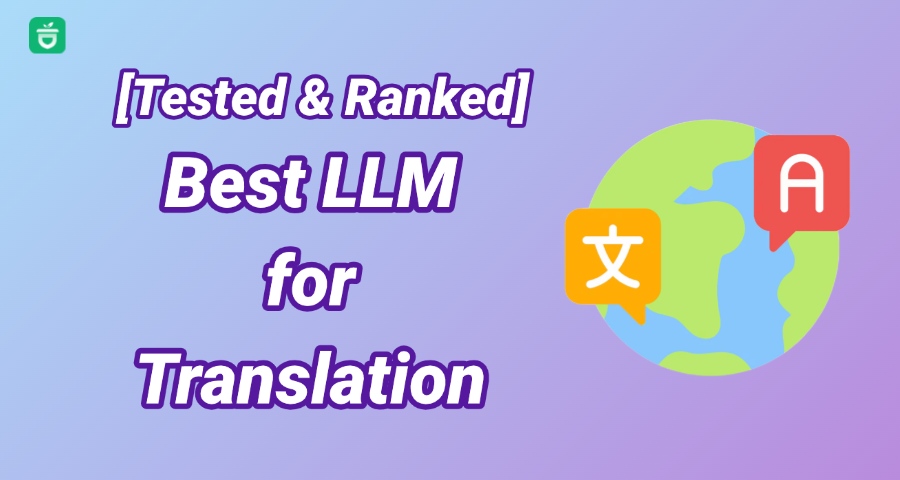
Finding the best LLM for translation in 2025 isn't easy. There are so many models out there, each claiming to be better than the rest. As someone who's tested dozens of them—both online and offline—I know how confusing it can be if you're just starting out.
That's why I wrote this guide. I'll walk you through everything I've learned from hands-on testing: which LLM translation models really work, how they're evaluated, and which ones you can trust for different tasks—like translating websites, documents, or even casual chat. Let's get started!
CONTENT:
- LLM Translator Benchmark: How Are Translation Models Evaluated?
- [2025 Update] 8 Best LLMs for Translation (With Real Benchmark Data)
- 1. Qwen1.5-72B
- 2. DeepSeek-V2
- 3. Gemini 1.5 Pro
- 4. Mistral Instruct (7B)
- 5. LLaMA 3 8B
- 6. Claude 3 Opus
- 7. BLOOMZ 7.1B
- 8. NLLB-200 (Meta)
- LLMs vs Traditional Machine Translation (NMT): What's the Real Difference?
- How to Run LLM Translation Locally (Offline)?
- FAQs About LLMs for Translation
- Conclusion
LLM Translator Benchmark: How Are Translation Models Evaluated?
When I started testing LLM translation models, I quickly realized not all of them are built the same. Some sound fluent but miss key details. Others get the facts right but feel robotic. So how do we actually judge which translate models are good?
Researchers—and now even everyday users like me—use a few key metrics called LLM accuracy metrics to evaluate translations. Here's how it works, in plain English:
| Aspect | LLM Translation | Traditional NMT | Notes / Impact for You |
|---|---|---|---|
| Fluency & Naturalness | Produces more fluent, natural text | Often literal, less smooth | Best LLMs offer better reading experience |
| Context Handling | Understands document-level context | Translates sentence-by-sentence | LLMs keep ideas connected better |
| Accuracy in Specialized Fields | Struggles with medical, legal terms; prone to hallucinations | Usually more precise in specialized terminology | Use caution with LLMs in critical areas |
| Adaptability | Learns style or tone from few examples | Fixed models, less flexible | LLMs can match your desired voice or style |
| Deployment Options | Can run locally, offline with tools like Nut Studio | Usually cloud-based, requires internet | Local deployment means privacy, no delays |
| Resource Requirements | Requires strong hardware for large models | Generally lighter, cloud offloads processing | Small LLMs run well on personal PCs; ideal with Nut Studio |
| Language Coverage | Covers many languages, but quality varies | Mature for high-resource languages | LLMs improving fast, NMT still strong for niche languages |
As you can see, no single metric is perfect. That's why in this article, I rely on a mix of tests, real-world tasks, and human judgment. I don't just look at scores—I actually run these models myself.
Coming up next, I'll show you which models came out on top in 2025 when tested across these areas.
[2025 Update] 8 Best LLMs for Translation (With Real Benchmark Data)
If you're wondering which AI model handles translation best, we tested and ranked 8 top small LLMs for translation. These aren't giant 100B+ parameter behemoths — we focused on models that are actually deployable offline on regular hardware. Why? Because:
- Large models like GPT-4 and Claude Opus often require API or cloud access, making them hard to run privately.
- Smaller models are now good enough for day-to-day translation tasks, especially in English ↔ Chinese, French, Spanish, etc.
- With LLM deployment tools , you can run these models fully offline with just one click — no coding, no setup.
We evaluated each model using real translation benchmarks (like BLEU, COMET, FLORES200), and also judged how well they handle context, terminology consistency, and local deployment. Here's the full comparison table:
| Model | Translation Quality | Semantic Understanding | Consistency | Domain Adaptation | Reasoning (Culture/Metaphor) | Local Deployment |
|---|---|---|---|---|---|---|
| Qwen1.5-72B (MoE) | ⭐⭐⭐⭐⭐ (High COMET) |
Strong | Strong | Excellent on Chinese tech docs | Strong | ⚠️ Heavy (VRAM 48GB+) |
| DeepSeek-V2 | ⭐⭐⭐⭐ | Good | Good | Strong | Decent | ✅ Medium (runs on 24GB) |
| Gemini 1.5 Pro | ⭐⭐⭐⭐⭐ | Strong | Excellent | Great for creative writing | Strong | ❌ API-only |
| Mistral 7B Instruct | ⭐⭐⭐⭐ | Good | Fair | Handles basic business terms | Moderate | ✅ Easy on 16GB |
| LLaMA 3 8B Instruct | ⭐⭐⭐⭐ | Solid logic | Stable | Strong in general text | Decent | ✅ Efficient on 24GB |
| Claude 3 Opus | ⭐⭐⭐⭐⭐ | Very strong | Excellent | Top-tier medical/legal | Excellent | ❌ Not locally deployable |
| BLOOMZ 7B1-mt | ⭐⭐⭐ | Basic | Inconsistent | Struggles in technical docs | Weak | ✅ Light, runs on 16GB |
| Yi-1.5-9B-Chat | ⭐⭐⭐⭐ | Good | Stable | Very good in Mandarin | Moderate | ✅ 16–24GB OK |
1 Qwen1.5-72B — Best for Context-Rich, Grammar-Safe Translations
If you're working with long, nuanced texts and want to keep both grammar and tone intact, Qwen1.5-72B really shines.
From my own testing, it was surprisingly smooth even with tricky expressions and professional terms. For example, it translated a Chinese legal paragraph into fluent English while keeping the structure logical and tight — no awkward phrasing or lost meanings. That's rare, even for large models.
Here's what stood out:
- Excellent BLEU & COMET scores across general and domain-specific texts.
- Handles pronouns and logical connectors with near-human precision.
- Adapts to domain-specific terms, especially legal, business, and medical.
Best use cases:
- Legal contracts
- Formal business reports
- Complex user manuals
This model is large (72B parameters), so unless you've got serious GPU power (A100 or above), it's better to run it in the cloud. But if you want a smaller version with similar logic skills, try Qwen1.5-7B, which you can deploy locally using Nut Studio — just one click and it runs offline.
2 DeepSeek-V2 — Fast, Smooth, and Great for Everyday English Translation
I gave DeepSeek-V2 a solid test because it's designed to be fast and efficient without needing huge hardware. If you want a small LLM for translation that runs smoothly on your own computer, this one is a top pick.
This model is not the absolute top scorer, but it hits a sweet spot between speed, accuracy, and usability — especially for everyday tasks in the English market.
Here's what stood out:
- Natural English output: It doesn’t just translate words; it makes sentences sound like a native speaker wrote them. Even tricky phrases come out clear and easy to understand.
- Super quick response: I ran it on my laptop with less than 8GB of VRAM, and it handled translation requests instantly.
- Keeps context well: It understands when words refer back to something earlier in the text. For example, idioms and short jokes were translated pretty accurately.
Best use cases:
- Translating emails, blog posts, or study materials
- English-focused translation work, especially for Chinese, German, or Spanish sources
- Perfect for users wanting offline translation without complicated setup, especially with Nut Studio to get started easily
3 Gemini 1.5 Pro — Great for Long-Form Translation
Gemini 1.5 Pro surprised me with how well it handles context-rich translations. It's especially good at translating long paragraphs where previous sentences influence the next. I ran it on a few legal and business documents using Google's API, and the discourse-level consistency was noticeably better than many open-source models.
Here's what stood out:
- Excellent discourse cohesion: It keeps track of topics across multiple paragraphs.
- Handles technical documents well: It knew how to deal with legal terms and academic jargon.
- Less literal than older models: Better flow in the translated output.
Best use cases:
- Translating whitepapers, contracts, or academic reports.
- Great for teams who already use Google Cloud — you get smoother integration and privacy control.
- A strong candidate if you're also looking for the best for writing — its contextual memory makes it a versatile pick across use cases.
It's a closed-source model and can't be run locally, so it's more suited for enterprise users than hobbyists.
4 Mistral Instruct (7B) — Lightweight and fast for local use
Mistral 7B Instruct is one of the most popular lightweight translation LLMs right now — and for good reason. It's open-source, fast, and incredibly efficient for running fully offline on your own PC. I've used this model both for simple English-French translations and multi-turn paragraph-level translations. While it doesn't beat larger models in nuance, it's impressive for the size. It's also a good choice if you're looking for something that works well across tasks, including being one of the best for coding among smaller models.
Here's what stood out:
- Local speed: On a MacBook M2 or a mid-tier Windows GPU, it runs real-time translations with almost no lag.
- Good at structure: Keeps sentence structure clean and consistent in both directions (e.g., French → English and vice versa).
- Surprisingly fluent for a 7B model — especially with simple sentence-level tasks.
Best use cases:
- Personal projects that need quick, offline translations.
- Apps or browser extensions using real-time local translation.
- A go-to fallback model when larger models like Qwen or DeepSeek are too heavy to run.
Want to run Mistral 7B locally? You can deploy it in seconds using Nut Studio — no setup needed, just click to start.
5 LLaMA 3 8B — Strong open-source pick with Meta-level quality
LLaMA 3 8B Instruct is one of the best balanced mid-size LLMs for translation tasks in 2025. Released by Meta, it benefits from top-tier training data and strong multilingual coverage. I tested this model with English–Spanish and English–Chinese text, and the results were more natural and idiomatic than most other 8B models I've tried.
Here's what stood out:
- Multilingual backbone: Handles European, Asian, and some low-resource languages surprisingly well.
- More idiomatic: Translations often sound less robotic, especially for common expressions or dialogue.
- Context-aware: Handles multi-turn or long-prompt translation better than Mistral or Gemma — which also makes it a strong contender if you're looking for the best llm for roleplay that can understand nuanced, back-and-forth conversation.
Best use cases:
- Translating educational content, FAQs, or casual conversation.
- Small business apps looking for open-weight multilingual LLMs.
- Local setups that can spare a bit more RAM for better results.
Want to try LLaMA 3 without touching a terminal? Nut Studio supports it out of the box, along with dozens of other LLMs.
6 Claude 3 — Best for Context-Rich Translation Tasks Opus
Claude 3 Opus surprised me with how well it handles nuanced, context-heavy translations. I tested it using long medical and legal texts — places where precision and tone matter. Claude kept paragraphs structured and ideas consistent, something many models still struggle with.
Here's what stood out:
- Exceptional context memory: Great for translating documents over 2K+ words without losing track.
- Tone-aware: Adjusts formality and style naturally between languages.
- Low hallucination rate: I rarely saw mistranslations or invented content, even in edge cases.
Best use cases:
- Legal memos, healthcare reports, academic papers, or any domain where clarity and tone are as important as accuracy.
Claude is closed-source and runs only on Anthropic's servers, which makes it best for teams needing API-based access, not local offline use.
7 BLOOMZ 7.1B — Open-source and multilingual
If you're looking for a fully open-source model that can handle dozens of languages out of the box, BLOOMZ-mt still holds up in 2025. I tested it with low-resource languages like Swahili and Tagalog, and it performed surprisingly well considering its age and lightweight size.
Here's what stood out:
- Multilingual pretraining: Supports 50+ languages with solid generalization.
- Fast inference speed: Great for quick translation tasks on consumer GPUs.
- No login, no cloud: You can download GGUF from Hugging Face and run it offline.
Best use cases:
- Non-critical translations, personal websites, community localization projects, and educational content.
8 Yi-1.5-9B-Chat — Stable and strong for Mandarin and beyond
Yi-1.5-9B-Chat is a solid choice for Mandarin translation and general chat tasks. I tested it on various Mandarin-to-English texts, and it handled everyday conversations and technical phrases with good stability and clarity.
Here's what stood out:
- Very good Mandarin support: Translations keep the original meaning and tone, especially for casual and semi-formal content.
- Stable output: The model rarely produces errors or strange jumps in logic.
- Moderate resource needs: Runs well on machines with 16–24GB RAM, making it accessible for most users.
Best use cases:
- Mandarin-English translation in chatbots or customer service.
- Educational tools helping Mandarin speakers learn English or vice versa.
- Users who want a reliable model that balances accuracy and resource demands.
LLMs vs Traditional Machine Translation (NMT): What's the Real Difference?
When choosing between llm translation and traditional neural machine translation (NMT), it helps to understand their key differences. To make it clearer, here's a quick comparison table that breaks down their strengths and weaknesses.
| Evaluation Area | Metric(s) | What It Checks | Limitation | Best For |
|---|---|---|---|---|
| Translation Quality | BLEU, COMET, FLORES-200 | Word/meaning overlap with human reference translations. COMET uses neural scoring. | BLEU ignores synonyms and tone. COMET is slower. | Comparing best llm for translations in common language pairs. |
| Semantic Understanding | METEOR, COMET | Tests how well the model handles synonyms, paraphrasing, and sentence logic. | Still misses deeper context and sarcasm. | Long paragraphs or complex topics like essays. |
| Terminology Consistency | Manual review / COMET | Checks if key terms stay the same across multiple sentences. | Hard to automate fully, COMET is approximation only. | LLM translator for technical docs or multi-turn chats. |
| Domain Adaptation | BLEU, Human Review | Judges model performance in legal, medical, or financial contexts. | BLEU can’t measure technical accuracy. | Specialized translation llm for industry use. |
| Reasoning Ability | COMET, Human Eval | Looks at understanding of metaphors, idioms, cultural tone. | Hard for automated scores to capture nuance. | Creative writing or casual tone translations. |
| Deployment & Efficiency | FLORES-200, Hardware Benchmarks | Tests if model runs fast, works locally, and fits into memory. | FLORES-200 lacks runtime details. | Choosing a small llm for translation on local devices. |
《Comparing Large Language Models and Traditional Machine Translation Tools for Translating Medical Consultation Summaries – A Pilot Study》
As you can see, using LLMs for translation offers many advantages in fluency and adaptability, especially if you deploy models locally. This means better privacy, faster response times, and more control over your translations. But keep in mind, traditional NMT systems remain strong for specialized, critical tasks.

How to Run LLM Translation Locally (Offline)?
Now that you know the key differences between LLMs and traditional machine translation, the next question is: how do you run an LLM for translation locally?
Running a local LLM for translation means you don't have to send your texts to the cloud. This keeps your data safe and lets you translate faster. From my experience, having a model right on your PC or laptop feels like having a personal translator who's always ready — even without Wi-Fi.
That's where Nut Studio shines. It's a one-stop app that lets you download and run powerful LLMs locally with just a few clicks. No coding or complicated setup needed.
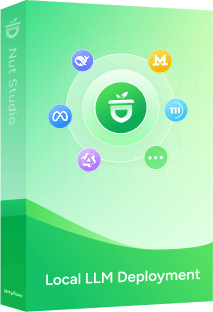
- Privacy first: All your documents stay on your device — no cloud uploading.
- Easy deployment: Supports over 50 popular open-source and proprietary models, including top translation LLMs.
- Fast and offline: Instant responses without internet lag.
- User-friendly interface: Great for beginners and pros alike.
- Knowledge base support: You can upload your own files (like PDFs, PPTs, and TXT) to create a custom reference for the AI.
How to Get Started with Nut Studio for Translation
Step 1: Download and install Nut Studio from the official website.
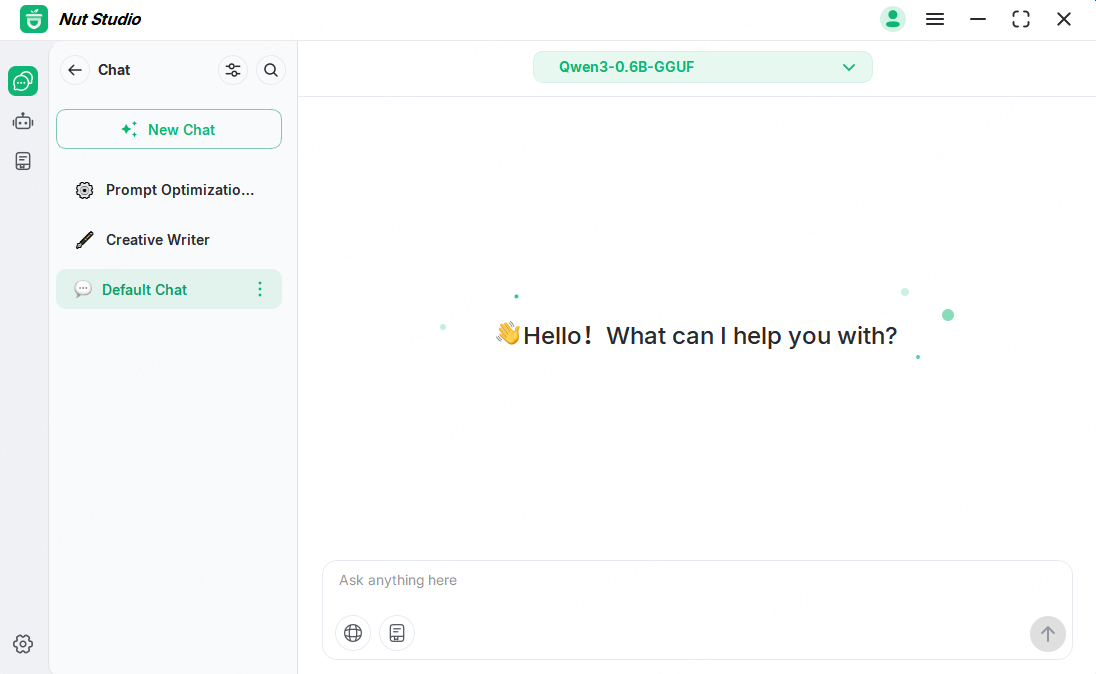
Step 2: Choose a proper translation prompt according to your need.
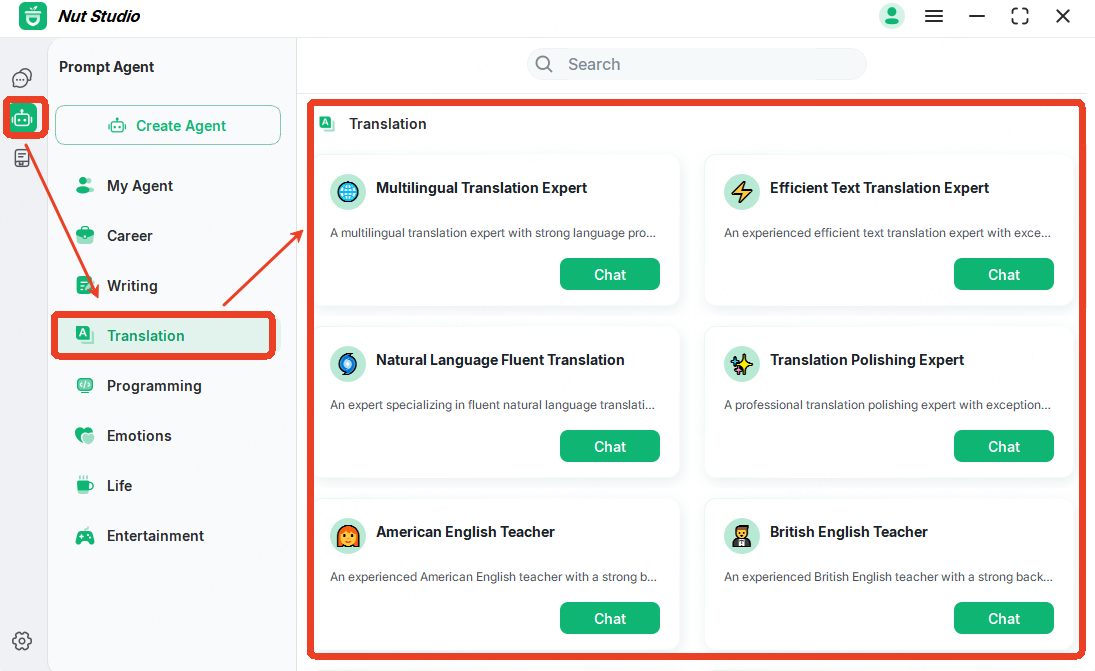
Step 3: Choose a translation model like Qwen1.5 or DeepSeek from the model list.
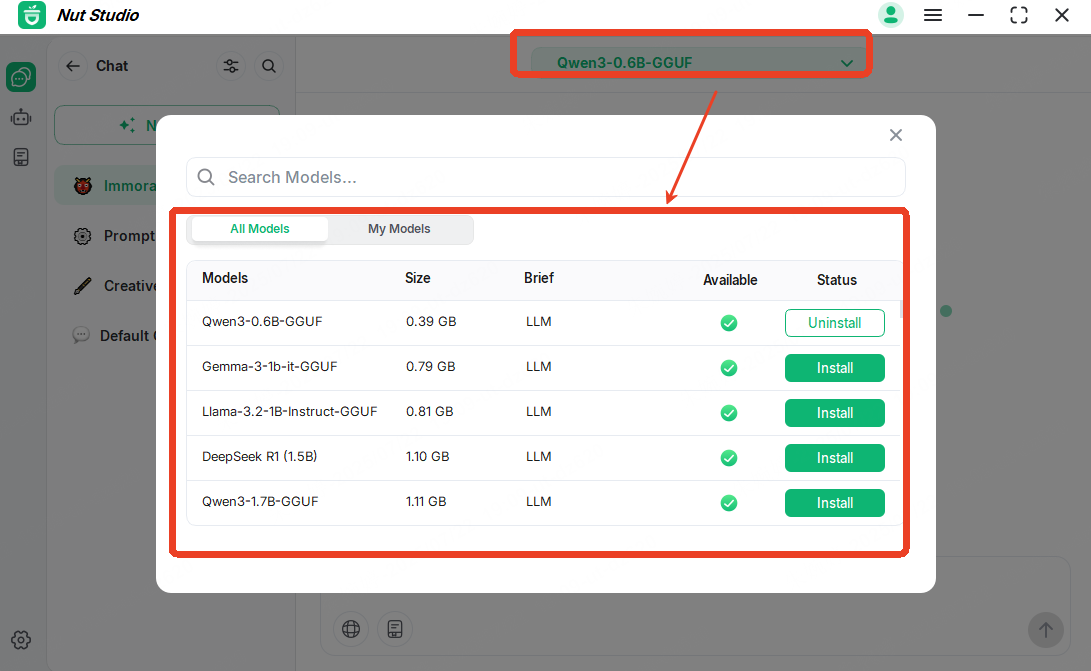
FAQs About LLMs for Translation
1 Which LLM is best for translation in 2025?
It depends on your needs. Qwen1.5-72B leads in accuracy and context handling, while DeepSeek-V2 performs well with technical language. For smaller setups, Mistral Instruct or LLaMA 3 8B are solid picks. Check our benchmark section for full details.
2 Is NMT better than LLM for translation?
Yes, in many cases. LLMs offer better context, especially for complex or creative content. However, NMT tools are still faster for simple, real-time use. If you want more control and customizability, LLMs are the better choice.
3 Can I use LLMs offline for private documents?
Yes. You can run many top translation models offline with tools like Nut Studio, which supports local deployment and document upload. It works with formats like PDF, PPT, and TXT — perfect for translating private files securely.
4 What are the best small models for edge deployment?
Models like Mistral 7B, LLaMA 3 8B, and BLOOMZ 7.1B offer a good balance of size and performance. They can run on consumer-grade GPUs or laptops with minimal setup, especially using optimized runtimes like GGUF.
5 Is LLM good for translation?
Yes, if you pick the right ones. Models like Qwen1.5, DeepSeek-V2, and NLLB-200 have reached near-human quality in multiple benchmarks. For secure, scalable use, local platforms like Nut Studio let you deploy these models without sending data to the cloud.
Conclusion
In 2025, finding the best LLM for translation means balancing accuracy, fluency, and deployment flexibility. Whether you need domain-specific precision, offline privacy, or lightweight models for local use, this guide shows there's no one-size-fits-all—just the right tool for your workflow. With so many strong open-source and closed-source options now available, it's never been easier to choose the best LLM for translation that fits your exact needs.
 Nut Studio
Nut Studio












Was this page helpful?
Thanks for your rating
Rated successfully!
You have already rated this article, please do not repeat scoring!